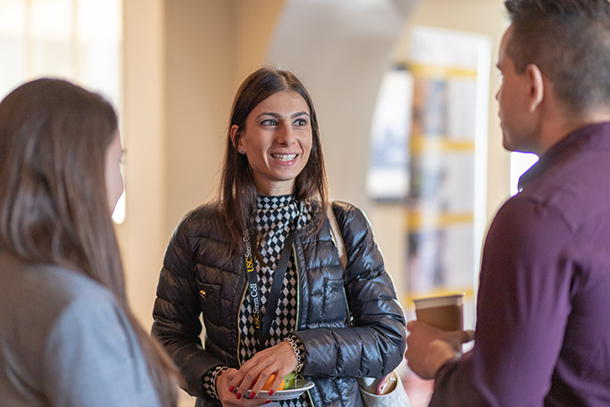“The field of stem cell biology is one of our great convergence opportunities,” said USC Provost Michael Quick, PhD, addressing an audience of biologists, chemists, physicists, engineers, clinicians and many others. This diverse group came together for the Interdisciplinary Stem Cell Symposium, hosted by USC Stem Cell and the USC Medicine, Engineering, Science and Humanities (MESH) Academy.
As the leader of USC Stem Cell, Andy McMahon, PhD, highlighted how this university-wide initiative promotes convergence — from shared research facilities, to fellowships and pilot collaborative research funding, to educational programs and scientific meetings.
“We launched USC Stem Cell as a cross-campus initiative about five years ago,” said McMahon, who also is W.M. Keck Provost Professor of Stem Cell Biology and Regenerative Medicine and Biological Sciences; and chair of stem cell biology and regenerative medicine at the Keck School of Medicine of USC. “It seemed natural with the new initiative that Steve Kay is launching, the MESH Academy, to put ourselves together and hold this symposium.”
Kay, PhD, DSc, Provost Professor of Neurology, Biomedical Engineering and Biological Sciences, and his colleague Amanda Mason introduced MESH’s mission to promote cross-disciplinary, cross-campus convergence.
“MESH focuses on innovation and entrepreneurship, connection among our scientists, and innovative education programs that leverage our transdisciplinary culture,” said Kay, who also is director of the MESH Academy. “Building this kind of cooperative culture is what this type of symposium is all about.”
Showing collaborations
Throughout the symposium, scientific talks demonstrated convergence in action through collaborations between researchers from different disciplines.
Stem Cell scientist Qi-Long Ying, PhD, professor of stem cell biology and regenerative medicine at the Keck School, and chemist Chao Zhang, PhD, associate professor of chemistry and biological sciences at the Dornsife College of Letters, Arts and Sciences, are working together to use custom-designed chemicals as probes to understand the molecular underpinnings of stem cell self-renewal and differentiation.
Two interdisciplinary talks addressed a new imaging technology called FLIM. Stem Cell scientist Rong Lu, PhD, assistant professor of stem cell biology and regenerative medicine at the Keck School, and engineer Keyue Shen, PhD, assistant professor of biomedical engineering at the USC Viterbi School of Engineering, are using FLIM to more effectively identify blood stem cells based on their metabolic profiles. Amir Goldkorn, MD, associate professor of medicine, and Cosimo Arnesano, PhD, MBA, research associate at the Translational Imaging Center, are using FLIM to track cancer cells as they transition in and out of an aggressive, cancer stem cell-like state. Both projects tap into expertise from the Translational Imaging Center, led by Scott Fraser, PhD, Provost Professor of Biological Sciences and Biological Engineering.
Cancer biologist Min Yu, MD, PhD, assistant professor of stem cell biology and regenerative medicine, and bioengineer Pin Wang, PhD, professor of chemical engineering, outlined their approach for engineering a nano-particle to deliver a drug to treat breast cancer.
Physicist turned biologist Peter Kuhn, PhD, talked about a “liquid biopsy,” which uses a simple blood draw to sample metastatic tumor cells circulating through a patient’s veins. In patients with prostate cancer, his team can use this biopsy to identify and target the underlying drivers of their disease with personalized drugs.
Gerontologist Valter Longo, PhD, professor at the Leonard Davis School of Gerontology, talked about how cycles of periodic fasting — or near fasting — promote blood stem cell activation, self-renewal and regeneration both in young and old animals.
Several talks highlighted stem cell-based approaches to treat orthopaedic problems.
Denis Evseenko, MD, PhD, associate professor of orthopaedic surgery and director of skeletal regeneration, discussed how to drive human stem cells to produce mature joint cartilage to treat arthritis. Evseenko’s team is preparing to apply for permission from the FDA to test these cells in a phase I clinical trial.
Yang Chai, DDS, PhD, director of the Center for Craniofacial Molecular Biology, and the Center for Dental, Oral and Craniofacial Tissue and Organ Regeneration (C-DOCTOR), talked about using a 3-D printed scaffold, loaded with stem cells, to repair large skull injuries that cannot otherwise heal. The project is partially funded by the Alfred Mann Institute (AMI) for Biomedical Engineering at USC. As part of the presentation, Winn Hong, MS, MBA, from AMI talked briefly how this institute promotes entrepreneurship among USC faculty.
Celebrating convergence opportunities
Expanding on the theme of convergence, Kyle McClary, founder of the USC Bridge Art and Science Alliance, discussed efforts to communicate science to the public through various art forms.
In the keynote address, Peter G. Schultz, President and CEO of the Scripps Research Institute highlighted his group’s approach for identifying potential drugs that change cell behavior for various chronic diseases such as arthritis, multiple sclerosis, liver disease and cancer. After the presentation, Schultz offered to screen his synthesized library for possible ALS therapies, in collaboration with USC Stem Cell scientist Justin Ichida, PhD.
Attendees also connected during a poster session and presentations, and had the opportunity to chat with potential collaborators during lunch, coffee breaks and a reception.
“It’s so good to see many from a variety of different disciplines here in the room today,” Quick said. “So I hope that this symposium will lead to a number of interdisciplinary collaborations, and a number of convergence opportunities for USC and beyond.”
— Cristy Lytal


